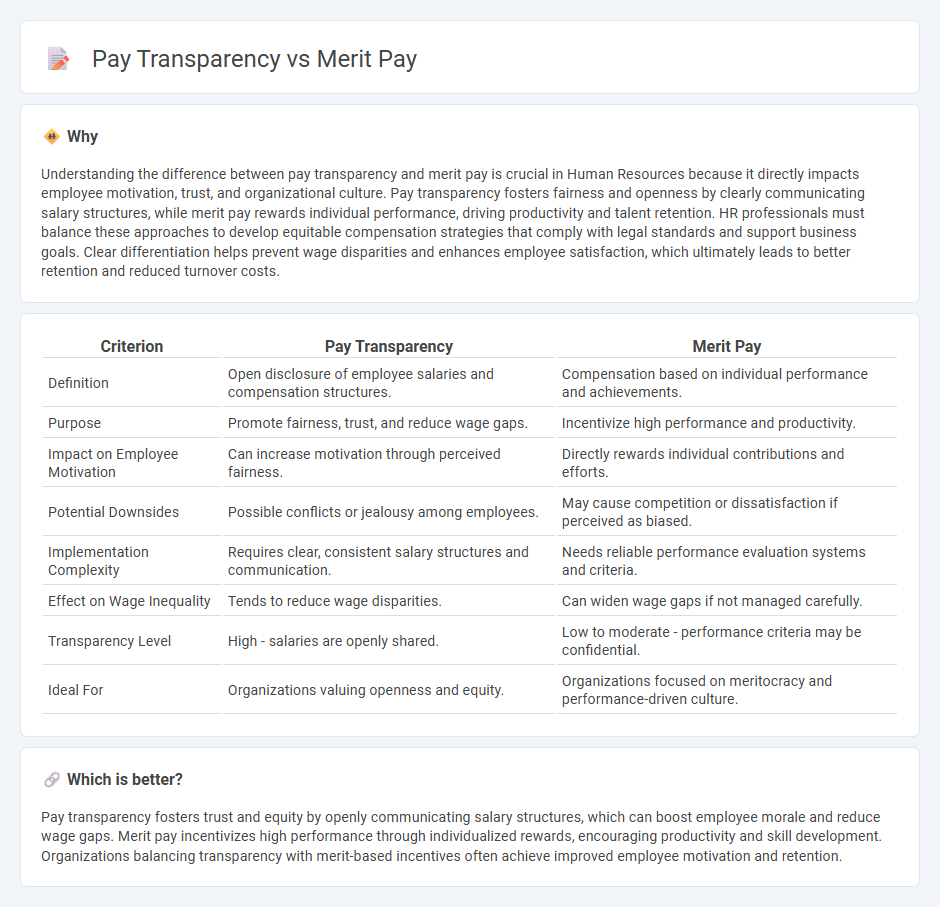
Pay transparency promotes open communication about salary structures, fostering trust and equity within organizations by reducing wage gaps and bias. Merit pay rewards individual performance, incentivizing productivity and aligning compensation with employee contributions to business goals. Explore the benefits and challenges of pay transparency versus merit pay to optimize your human resources strategy.
Why it is important
Understanding the difference between pay transparency and merit pay is crucial in Human Resources because it directly impacts employee motivation, trust, and organizational culture. Pay transparency fosters fairness and openness by clearly communicating salary structures, while merit pay rewards individual performance, driving productivity and talent retention. HR professionals must balance these approaches to develop equitable compensation strategies that comply with legal standards and support business goals. Clear differentiation helps prevent wage disparities and enhances employee satisfaction, which ultimately leads to better retention and reduced turnover costs.
Comparison Table
| Criterion | Pay Transparency | Merit Pay |
|---|---|---|
| Definition | Open disclosure of employee salaries and compensation structures. | Compensation based on individual performance and achievements. |
| Purpose | Promote fairness, trust, and reduce wage gaps. | Incentivize high performance and productivity. |
| Impact on Employee Motivation | Can increase motivation through perceived fairness. | Directly rewards individual contributions and efforts. |
| Potential Downsides | Possible conflicts or jealousy among employees. | May cause competition or dissatisfaction if perceived as biased. |
| Implementation Complexity | Requires clear, consistent salary structures and communication. | Needs reliable performance evaluation systems and criteria. |
| Effect on Wage Inequality | Tends to reduce wage disparities. | Can widen wage gaps if not managed carefully. |
| Transparency Level | High - salaries are openly shared. | Low to moderate - performance criteria may be confidential. |
| Ideal For | Organizations valuing openness and equity. | Organizations focused on meritocracy and performance-driven culture. |
Which is better?
Pay transparency fosters trust and equity by openly communicating salary structures, which can boost employee morale and reduce wage gaps. Merit pay incentivizes high performance through individualized rewards, encouraging productivity and skill development. Organizations balancing transparency with merit-based incentives often achieve improved employee motivation and retention.
Connection
Pay transparency enhances trust and motivation by openly sharing salary structures, which directly supports the effectiveness of merit pay systems tied to individual performance metrics. Transparent compensation frameworks enable employees to understand how merit-based increases are determined, fostering fairness and accountability in Human Resources practices. Integrating pay transparency with merit pay drives employee engagement, retention, and alignment with organizational goals.
Key Terms
Performance Evaluation
Merit pay systems directly link employee compensation to performance evaluations, incentivizing high achievers by rewarding exceptional results with salary increases or bonuses. Pay transparency involves openly sharing compensation information, fostering trust and allowing employees to understand how performance metrics influence pay disparities. Explore how combining merit pay with transparent evaluation processes can enhance motivation and fairness within your organization.
Compensation Disclosure
Merit pay systems reward employees based on performance metrics, creating a direct link between individual achievement and compensation adjustments, whereas pay transparency policies emphasize open communication about salary structures across an organization to promote fairness and trust. Compensation disclosure in merit pay can enhance employee motivation but might also lead to competition, while transparent pay practices reduce wage gaps and prevent discrimination by making salary data accessible to all staff. Explore the impact of compensation disclosure on organizational culture and employee satisfaction to understand the nuances between merit pay and pay transparency.
Equity
Merit pay systems reward individual performance but may inadvertently perpetuate pay inequities due to subjective evaluations and lack of transparency. Pay transparency enhances equity by openly sharing compensation data, reducing gender and racial wage gaps, and fostering trust within organizations. Explore how integrating pay transparency can create fairer merit-based compensation structures.
Source and External Links
Merit Pay at the University - Merit pay is a compensation program where increases to base pay are tied to individual performance, with pay increases varying based on job performance and approval from a governing board.
Merit Pay: Definition, Advantages and Disadvantages - Merit pay rewards higher-performing employees with ongoing additional pay based on measurable performance criteria, with advantages including increased productivity but potential drawbacks such as perceived favoritism.
Merit Pay: HR Terms Explained - Merit pay compensates employees based on individual achievement rather than seniority or hours worked, motivating higher performance and competition but posing challenges in fair implementation and possible workplace tension.
 dowidth.com
dowidth.com